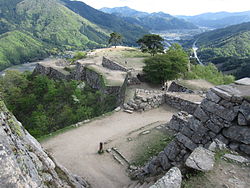Takeda Castle
| Takeda Castle | |
|---|---|
Trúc điền thành | |
| Asago, Hyōgo, Japan | |
 Takeda Castle | |
| Coordinates | 35°18′00″N134°49′44″E/ 35.30000°N 134.82889°E |
| Type | Mountaintop-style castle |
| Site information | |
| Owner | Yamana clan |
| Condition | ruins |
| Site history | |
| Built | c.1441 |
| Built by | Otagaki Mitsukage |
| Materials | Stone walls |
| Demolished | 1600 |
 | |

Takeda Castle(Trúc điền thành,Takeda-jō)was aSengoku periodJapanese castlelocated in theWadayamaneighborhood of the city ofAsago,in the northern part ofHyōgo Prefecture,Japan.[1]It is located north ofHimeji,and north-west ofKyoto,and is situated some 353 metres above sea level[2]It is often referred to locally as the "Machu Picchuof Japan ".[3]The castle was destroyed during theSengoku period,only its foundations and stone walls remain. The ruins have been protected as aNational Historic Sitesince 1943.[4]
History
[edit]Takeda Castle is located on Mount Shiroyama at a strategic location commanding the intersection of the San'indo highway fromTanbatoInaba Provinceconnects with the road south toHarima Provinceand theSeto Inland Sea.The castle is also close to theIkuno mine,one of the largest silver mines in Japan during theMuromachi period.[5]
The area came under the control of theYamana clan,a cadet branch of theNitta clan,in theMuromachi period.The Yamana clan had close relations with theAshikaga shogunateand was one of four clans with hereditary rights to the position ofSamurai-dokoro.The Yamana leveraged their position to eventually claim the position ofshugoover 11 of the 66 provinces of Japan. However, the Ashikaga grew fearful of the expanding power of the clan, and ShogunAshikaga Yoshimitsuencouraged internal conflicts within the clan and sponsored theHosokawa clanin its position ofkanreiof offset the Yamana. By the middle of the 15th century, the power the Ashikaga shogunate began to decline, and a succession dispute within the shogunate led to theŌnin Warfrom 1467 to 1477.[5]
Takeda Castle was built during this period by Otagaki Mitsukage, a retainer ofYamana Sōzen,in 1441; however, many details are unclear and this date is uncertain. The year 1441 is the year whenShogunAshikaga Yoshinoriwas assassinated by theAkamatsu clan.The Yamana clan and the Akamatsu clan went into war against one another, and Takeda Castle was constructed both to protect the Ikuno mine, but also to guard the border between Akamatsu-held Harima and Yamana-held Tajima. In 1468, a largeHosokawa clanarmy was defeated by Yamana forces led by Otagaki Mitsukage from Takeda Castle. The Ōnin War weakened the Yamana clan as the conflict extended into decades. Even within their strongholds Tajima itself, the Yamana mostly became nominal overlords as local retainers (such as the Otagaki) gained much independence. Under these circumstances, the clan was defeated in 1576 byToyotomi Hideyoshi.Yamana Suketoyomanaged to escape toSakaiand was pardoned by Nobunaga in 1570, and allowed to return to his ancestral territory in Tajima. Although he served Nobunaga loyally, in 1580 when Toyotomi Hideyoshi was fighting the Mōri clan, the Otagaki clan, defected to the enemy. Hideyoshi charged the Yamana with treason, and attackedArikoyama Castle,ending the power of the clan. Hideyoshi assigned the area to his younger brother,Toyotomi Hidenaga.[5]
Hidenaga appointed his generalKuwaharu Shigeharu(1524-1606) as castellan, but after Hidenaga was transferred toYamato Province,Hideyoshi placedAkamatsu Hirohide(1562-1600) as a governor of this castle. Under Hirohide, Takeda Castle was significantly reconstructed. Akamatsu retained the basic layout: from the summit of the mountain, three ridges extend outwards, and each ridge was shaped byenclosureswhich made extensive use of the natural terrain. Akamatsu added stone walls and dry moats.[5]
After the death of Hideyoshi, Akamatsu was initially loyal to theToyotomi side,but after theBattle of Sekigahara,changed his fealty toTokugawa Ieyasu.Ordered to attackTottori Castle,he was accused of setting fire to thejokamachiduring the siege and was forced to commitseppuku.Takeda Castle was destroyed at this time, but the foundations and stone walls were allowed to remain relatively intact.[6]
Due to its mountaintop location, often above the cloud layer, the castle ruins have become a popular tourist attraction. It is located a 60-minute walk fromTakeda Stationon theJR WestBantan Line,but the climb is very steep.[5]
Takeda Castle was listed as one ofJapan's Top 100 Castlesby the Japan Castle Foundation in 2006.[7]
Gallery
[edit]-
Takeda Castle
-
Stone wall of Hanayashiki compound
-
Gate of Tenshu tower
-
Honmaru compound
-
Minami Senjojiki compound
-
Stone wall of Mitsukeyagura tower
Literature
[edit]- De Lange, William (2021).An Encyclopedia of Japanese Castles.Groningen: Toyo Press. pp. 600 pages.ISBN978-9492722300.
References
[edit]- ^"Takeda Castle".Jcastle - Guide to Japanese Castles.Retrieved1 April2014.
- ^"Asago City | Takeda Castle Ruins".city.asago.hyogo.jp(in Japanese).Retrieved2018-05-05.
- ^"The Machu Picchu of Japan, Takeda Castle! | JAPAN VIDEOS - DISCOVER the SPIRIT of JAPAN".Archived fromthe originalon 2014-11-29.Retrieved2014-11-25.Accessed 2014-11-25
- ^"Trúc điền thành tích".Cultural Heritage Online(in Japanese). Agency for Cultural Affairs.Retrieved15 September2021.
- ^abcdeIsomura, Yukio; Sakai, Hideya (2012).( quốc chỉ định sử tích sự điển ) National Historic Site Encyclopedia.Học sinh xã.ISBN978-4311750403.(in Japanese)
- ^"Takeda Castle".jcastle.info. Archived fromthe originalon 2014-02-10.Retrieved2014-04-01.
- ^Japan Castle Foundation
External links
[edit]![]() Media related toTakeda Castleat Wikimedia Commons
Media related toTakeda Castleat Wikimedia Commons









